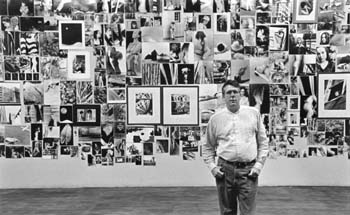Reflective Moment
Decades after working with Ansel Adams, being in Life magazine and suffering tragedy, Joseph Schuett finds form in downtown's buildings
By Michael Learmonth
The photographer pulls on a cigarette and surveys a wall covered with black-and-white photographs. He chooses one, an image of a little girl lying on her stomach and staring down at her own reflection in a pool of water. He pulls out the push-pins fastening the photograph to the wall and places it on the table.
Joseph Schuett made this picture when he was 19. Originally published in almost every major U.S. newspaper in 1972, the photograph was his first big break as an artist. Today, he is pulling it from the wall of his studio on The Alameda along with other photographs of children he's taken over his 28-year career. At 5pm, he will take them out of his portfolio and show them to a Cupertino couple who's considering hiring him to photograph their child.
Perhaps this couple, to whom the artist is hoping to prove himself, hasn't found the time to visit Schuett's one-man show of photographs of San Jose currently showing in the San Jose Museum of Art. They may also have missed the "Featured Artist" documentary about Schuett that premiered Nov. 7 on KTEH-Channel 54. Schuett will undoubtedly tell them that he's studied with Ansel Adams (wrote Adams a letter, in fact, at the age of 21); that he's been published in Life, Esquire and Rolling Stone; and that he's made at least 250,000 photographs.
Yet for all his success as an artist, Schuett hustles from job to job, hoping to teach enough classes and photograph enough babies to make the $3,000 rent on 4,000 square feet of an old roller-skating rink he rents on The Alameda.
"It is what it is," Schuett, 46, says of his life as an artist. "It's never filled with money."
Schuett's fluffy cat, Vincent, tiptoes across the vast wooden floor of his studio and jumps into his lap. As he strokes Vincent's unruly orange fur, Schuett recalls his first visit to California.
It was 1972, and Schuett had been accepted into one of Ansel Adams' three-week photography seminars in Yosemite National Park. Schuett packed his 4-by-5-inch view camera and drove from his native Chicago.
A few photographs of Adams are sprinkled in with the collage on Schuett's wall. "He was like a scientist or a mathematician," Schuett remembers. The Master always sported a big white beard and wore handmade cowboy boots and a bolo tie. And Schuett will never forget the first direction The Master gave to him: "Square root the ASA of the film speed to the nearest relative f-stop."
Schuett thought: "I've come a long way to find out I don't know a thing about photography."
Fortunately, most of Adams' lessons were more accessible, like always step on top of a log, never over. You never know what could be sitting, or rattling, as it were, on the other side.
A year later, Schuett experienced a tragedy that would indelibly mark his work. After moving west to Portland, his girlfriend was murdered by a deranged ex-high school football star who stabbed her 27 times.
Schuett escaped the pain through photography. Rather than document life in all its harsh realities and imperfections, Schuett began to search for beauty. The photographs on his wall reflect this search with his painterly treatment of female nudes, moving pictures of children and almost abstract architectural images.
Many of the female nudes were part of an exhibition called "The Angels." Exhibited in Chicago shortly before Schuett moved to San Jose, the photographs show no half-dressed models or seductive looks--just a reverence for the body's shape and form.
When he came to San Jose five years ago, Schuett was looking for a new subject and found it in the oft-derided glass boxes that form the city's skyline.
"I had done so much with people, and here I was in a new city seeing all these abstract reflections downtown," Schuett says.
It could be said that in the reflections of glass buildings often described by architecture critics as "faceless," Schuett has found a face.
The photographs are mostly the abstract, bent and distorted reflections of San Jose's architectural treasures in the windows of newer additions to the skyline. The De Anza Hotel is reflected in the windows of the Comerica Building, the Sainte Claire appears in the windows of the Convention Center and the Medical Dental building is projected onto the canvas of a San Jose police cruiser.
Schuett's work, titled "San Jose: A Museum of Reflections," is on display through December at the Museum of Art.
Part of Schuett hopes his rising profile in Silicon Valley will help making rent become less of a concern. But a bigger part knows that he would still do it whether the photographs were selling or not.
"I'm obsessed with doing it," he says. "I never thought about what it would be like."
[ Metro | Metroactive Central | Archives ]

From the Dec. 4-10, 1997 issue of Metro.
![[Metroactive Features]](/features/gifs/feat468.gif)